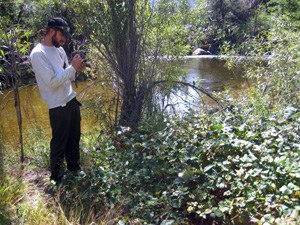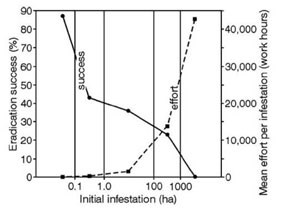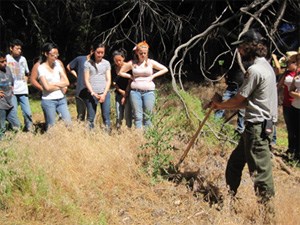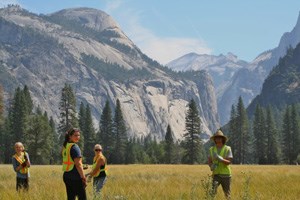
The goal of the Invasive Plant Management program is to provide a comprehensive framework to protect the park’s natural and cultural resources from the impacts of non-native invasive plants. Yosemite resource managers use Integrated Pest Management (IPM), a sustainable approach to managing pests, by combining the best available science and tools in a way that minimizes risk, whether human health, environmental, or economic. Elements of IPM include prevention, inventory/early detection, prioritization, treatment, monitoring, and education and outreach. Managers implement IPM through adaptive management which promotes flexible decision making to allow for program adjustments in the face of uncertainties and with an aim to reduce uncertainty over time via monitoring. This process allows resource objectives to be met while information is gathered and lessons are learned, in hopes of continually improving future management. Prevention measures also include working with contractors on two separate prevention programs; equipment inspection and pre-procurement gravel-pit inspection. All heavy equipment entering the park is inspected to make sure weed seed harboring soil is cleaned from the machine before it arrives at the park. All gravel, fill, topsoil, and other construction materials are sourced from within the park or from inspected gravel pits to reduce the introduction and spread of infestations. An additional preventative measure is the cooperation between Yosemite National Park and the park concessioner to use certified weed-free forage to feed stock. 
Inventory/Early DetectionThere are numerous ways in which invasive plant seeds can slip through the cracks of even the most rigorous prevention systems. Therefore, a system of early detection is necessary to enable a rapid management response to new invasions. The goals of the inventory component of IPM are to:
Catching infestations early enables managers to respond while populations are still small and easy to manage. This is critically important because the probability of eradication is much greater when invasive plant populations are small. The management response, therefore, requires far fewer personnel, equipment, and monetary resources, and would potentially use tools that are less intrusive to the surrounding landscape. In the figure below, one can see how dramatically the cost of control increases with increasing infestation size while the chance of success declines. 
In order to successfully manage invasive plants in Yosemite, it is important that we are aware of what we have, including the presence and absence of target species. All survey efforts are tracked even when no target species are found in order to improve the reliability of the mapping effort, and to improve our understanding of the likelihood of habitats to become invaded. This data provides for the prioritization and planning of treatments and the ability to assess the success of management actions. Because it is not practical to inventory each of the 761,266 acres within Yosemite National Park, inventories focus on areas most likely to be invaded, but include enough other sampling areas to inform managers about where invasive species occur or do not occur. High probability areas include both natural and manmade disturbance sites, particularly those exposed to a ready source of invasive plants propagules. Identifying pathways for invasive species entry and spread can help managers make informed management decisions regarding park prevention systems and early detection efforts. Maintaining an invasive species inventory is an ongoing process. Sophisticated mapping technology allows managers to inventory and document areas of concern and catalog how infestations respond to treatment over time. Unfortunately, Yosemite National Park has no dedicated funding for early detection survey work at the present time, hence, survey work as well as treatment work has to be carefully prioritized. The first comprehensive park-wide early detection survey was conducted between 2012 and 2014, funded by the Yosemite Conservancy. The goal of this project is to provide park resource managers with a comprehensive inventory of non-native plants and baseline data on their distribution throughout the park. Upon completion of the project, 30 new non-native plants have been discovered within the boundaries of Yosemite, including highly aggressive weeds such as Medusahead (Elymus caput-medusae) and rush skeleton weed (Chondrilla juncea). Additionally, isolated patches of high priority invasive plants such as velvet grass and cheat grass have been found in remote wilderness locations. View a poster showcasing the results of this project. [9.9 MB PDF] Another early detection effort in Yosemite is the Burned Area Rehabilitation (BAR) program. After major fires, Yosemite botanists conduct early detection surveys and enact rapid response treatments in all areas disturbed by firefighting operations that may be susceptible to new invasive species introductions. By finding these threats before they become established, park staff are able to control the infestations with minimal time and resources. Early detection efforts such as these protect valuable natural resources and have the potential to save thousands of dollars in the future. PrioritizationComprehensive invasive plant surveys in recent years have yielded observations of 275 non-native plant species within the boundaries of Yosemite National Park. The majority of exotic plants are relatively harmless as they are restricted to non-natural habitats with a regular disturbance regime, such as compacted roadside shoulders. Exotic plants that do not alter the natural community structure or ecosystem function may be a visual scar on the landscape to the trained eye, but are not a significant management concern. This is fortunate because the park cannot control all non-natives plants and must prioritize its limited resources on the most harmful species that can effectively be managed. Resource managers use a modified Alien Plants Ranking System (USGS 2000) to assess the degree that invasive species affect natural systems. Resource managers use this analytical tool to separate the innocuous species from the invasive ones and strategically prioritize individual plants as a 'high', 'medium' or 'low' based on the potential threat to park resources, range extent of species, and the ability to mitigate the spread of the invasive species. Park managers can then focus limited resources where they are needed most. Species such as Himalayan blackberry, are ranked 'high priority' as they form dense, uniform stands that exclude native species and alter natural disturbance regimes. Some highly invasive species (e.g., some Mediterranean grasses) are already so widespread within Yosemite and surrounding areas that their control is beyond what is currently feasible, and any attempts to control them would be a waste of resources. These species, even though they may negatively affect native plant communities, are assigned a lower priority for treatment. Prioritization is a dynamic process, and occasionally, ranking of individual species may shift due to changes in plant behavior over time. For example, the exotic species velvet grass was first documented in Yosemite in 1919, but its non-invasive behavior did not warrant focused treatment for many decades. By 2006, managers recognized that velvet grass was aggressively spreading from established patches and assigned it a high priority for control. Like velvet grass, it is a possibility that some of the non-aggressive 'low priority' weeds may become a problem in the future, further stressing the need for a comprehensive and up to date inventory. Invasive species that have not yet been found in the park, but have proven to be problematic in similar habitats are placed on a watch list [113 kb PDF] if their arrival in the park is anticipated. Park botanists and invasive plant staff specifically study those species in order to quickly detect them should they arrive. ControlWith the prioritization of Yosemite's invasive plant inventory, staff are able to implement the most appropriate control technique (i.e. manual control, mechanical control, herbicides) for each individual threat. Control operations can vary greatly from species to species depending on environmental factors and specific plant characteristics. Invasive plant control efforts are monitored in order to determine the efficacy of treatment methods and need for additional control measures. Learn more about Yosemite's control techniques. MonitoringInvasive plant control efforts are monitored to determine whether management objectives are being met and to ensure the effectiveness of control treatments. Monitoring data provides the necessary detail of post-treatment condition and compares it to pre-treatment data. The quality of monitoring is dependent on the sufficiency of baseline inventory information. The extent of monitoring can vary from year to year depending upon the needs of the program and the availability of funding and staff. Effective monitoring goals are those that are well-defined, easily quantifiable, and time specific. Trend monitoring includes the following:

The elements of monitoring allow for an adaptive approach so that park managers can adjust control methods as necessary to improve treatment success in the future. Monitoring is a crucial step in an iterative process that can benefit land managers in other parts of the Sierra Nevada and elsewhere. Land managers from other regions can learn from treatment successes and failures documented in Yosemite, thus, informing and assisting with their management decisions. Additionally, this information can be synthesized in ways that incorporate diverse methods of outreach and education to reach a greater audience. 
Research, Education, and OutreachInventory, monitoring, and other methods of data collection inform invasive plant management decision making, Program managers conduct literature reviews on published research relevant to invasion ecology and the management of invasive plants, which can be incorporated during annual review of the program's management objectives. Staff attend the invasive plant symposium held annually by the California Invasive Plant Council in order to stay connected with Integrated Pest Management developments in California, and increase communication and collaboration with other California land managers on invasive plant issues. Diverse education and outreach efforts can foster understanding of invasive plant prevention and control to a wide range of audiences. One method includes educating, training, and using volunteers, who are an essential component of invasive plant management in the park. Volunteering allows members of the public to forge a deeper relationship with the park, and become stakeholders in park resource challenges. Many volunteers return year after year to work on projects that they have become connected with. Volunteers are the frontline defense against invasive plants like bull thistle (Cirsium vulgare) in Yosemite Valley meadows and the Mariposa Grove. Additionally, restoration projects throughout the park that help foster ecosystems resilience to invasion rely heavily on volunteers. Yosemite would not be able to achieve the many resource management goals set forth without the support of dedicated volunteers. Learn more about how to become a volunteer. Yosemite posts the Invasive Plant Management annual work plan on the park's website, as well as in newspapers, journals, conferences, brochures, and visitor center exhibits. This strategy allows the park to communicate invasive plant research and other relevant information to park staff, partners, and visitors. Other outreach materials are created periodically to keep the public well informed about current and ongoing projects. For example, information about velvetgrass [1.1 MB PDF] and the Ahead of the Spread [9.9 MB PDF] project, can be expressed through informative posters. The CalFlora Observer Pro App for smart phones and tablets is the product of collaboration between Yosemite National Park, other California land management agencies, and CalFlora, a non-profit dedicated to the conservation, education, and appreciation of California plant life. This app allows anyone to upload plant observations to a publicly available online database. This greatly increases the ability for early detection and rapid response by inviting the public to contribute their plant observations directly to the park with the push of a few buttons. This database is used throughout California, and will help the invasive plant management community as a whole. Download the app for Android or Apple devices. Interpretive programs and periodic exhibitions at the Yosemite Valley visitor center educate the public about the threats posed by invasive plant species and actions taken to protect park resources from their introduction and spread. Partnerships with other park entities such as our concessioner, Yosemite Conservancy, and NatureBridge are especially important for prevention and early detection of non-native invasive species. Several nationwide programs offer resources that aid efforts to combat invasive species such as: Inventory and Monitoring and Cooperative Weed Management Areas. Additionally, the National Park Service has established 16 Exotic Plant Management Teams across the country to work across 225 parks. These regionally specialized teams assist parks with ongoing efforts to remove invasive plants and provide management guidance for invasive plant control in individual parks. Other methods of outreach include placing invasive plant awareness messages at trailheads and information kiosks, and including weed prevention guidelines on wilderness permits and construction and commercial use authorizations. 
Do Your Part to Help!VolunteerYou can do your part to help keep Yosemite beautiful. Work alongside park biologists to remove invasive plants throughout the park. Many group work projects, which include invasive species removal as well as other natural resources projects, can be scheduled in advance through the volunteer office. Call 209/379-1308 to register. Learn more about volunteering in Yosemite. Map Invasive Plants Using Your Smart Phone with CalFlora Observer ProDid you know that you can help fight weeds in Yosemite National Park with your smart phone? Yosemite teamed up with CalFlora, The Yosemite Conservancy, and other land management agencies to develop an easy to use smart phone app that allows you to contribute valuable data to your park. If you encounter invasive plants during your visit, use this app to simply Download the app for Android or Apple devices. Be a Conscious ShopperDon't plant invasive species! Hand out this wallet-sized card [18 kb PDF] to California nurseries that sell invasive species. View a list of Yosemite's non-native plants. Become a Yosemite Conservancy DonorYosemite Conservancy donors fund projects that restore habitat, including invasive plants removal. Yosemite's Invasive Plant Management Plan and Annual Work Plan
|
Last updated: December 2, 2025
